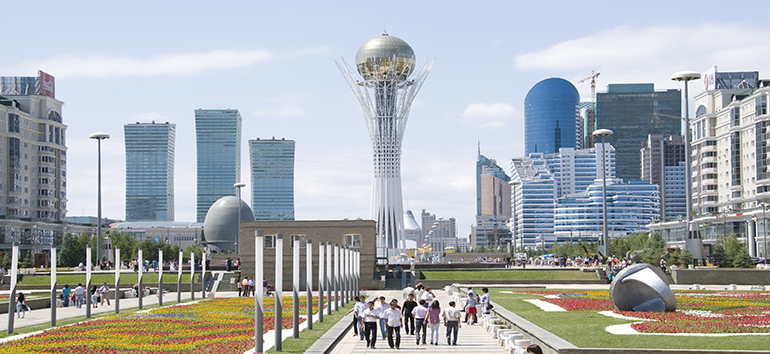NUR-SULTAN – The European Bank for Reconstruction and Development (EBRD) approved the new strategy for Kazakhstan for the next five years with a focus on private sector competitiveness, economic inclusivity, and carbon neutrality, the bank’s press service announced on Tuesday.

View on the city center. Photo credit: ebrd.com
The bank has invested more than US$10.3 billion in the country to date, the largest of the EBRD operations in Central Asia.
The Central Asian nation, which has relied significantly on its vast natural resources and mass oil and gas revenues for years to support the economic growth, now faces what EBRD describes as “formidable challenges to navigate safely into a sustainable growth model.”
“This reconciles its green ambitions with the need to integrate its population across its vast distances, whilst ensuring a level playing field that allows for the emergence of a solid small and medium-sized corporate sector. Transition gaps remain particularly acute in the green space, where coal continues to dominate the country’s electricity generation and low resource efficiency across water, energy and waste management, and the inclusion space, where the country’s extreme regional diversity in natural resource endowment, soil and climate conditions, and demographics and industry structure creates unique social and economic inclusion challenges,” reads the strategy.
According to EBRD Director for Kazakhstan Huseyin Ozhan, the strategies are based on both the past performance and the future priorities.
“These strategies need to be in conjunction with the needs of the country and the reform program that the country has. It is a combination of a number of factors that go in there and that is how we identify the priorities now,” he told The Astana Times.
In its work in the next five years, EBRD, which this year marks 30 years since Kazakhstan joined the bank, will focus on three pillars.
Under the first pillar – fostering private sector competitiveness, connectivity and strengthening economic governance – the bank plans to invest in the digitalization of infrastructure, improving transport and logistics infrastructure and providing finance and capacity building to partner banks and microfinance institutions and advising financial regulators on improving corporate governance, risk management and other aspects of financial sector regulation.
“The country’s strategy will increase the level of digitalization and innovation. We want to see more FDI (foreign direct investments) into the country and increase expertise and the standards that come with this FDI. We want to see improved international connectivity and this became extremely topical, given the current geopolitical situation in the world. What we want are improved governance and the necessary skills,” said Ozhan.
The second pillar envisions support for Kazakhstan’s effort to achieve carbon neutrality, a pledge the country has committed itself to by 2060.
In its previous strategy, the EBRD provided significant support to the country to develop its renewable energy potential. One of the biggest projects was financing the construction and operation of 12 solar projects for 588 megawatts with a total value of EBRD financing of €328 million (US$341.2 million).
As part of the new strategy, EBRD will continue this effort as well as the decarbonization of the energy sector and improving resource efficiency and climate resilience – all in line with Kazakhstan’s drive to develop Paris Agreement-aligned strategies.
Promoting economic inclusion and gender equality through private sector engagement is the third pillar of the new strategy, which implies working with the public and private sectors to ensure a diverse and inclusive workforce, supporting women-led businesses, introducing alternative financing mechanisms to groups that often do have limited access to traditional financing and empowering region’s financial capacity, among other tasks.
Ozhan stressed the importance of reducing inter-regional disparity, part of the third pillar.
“When you look at the January events, it started out from these inter-regional disparities,” he added.
In formulating the strategy, EBRD stems from what needs to change in a country.
“In other words, we can call this the country’s diagnostics, and then we need to see whether it can be changed and this is the political economy part. And then we also need to look at what the bank can do, and that is the capabilities and the bank’s ability to deliver in the country that we operate in,” said Ozhan.
When asked what the difference between the previous strategy for 2017-2021 and the new one, Ozhan said the latter one is more focused.
“We used to have four priorities, now we have three to deliver a more focused approach in the country. And then again, we also do have a lot of cross-cutting themes that we work on, which might not be looked at or named priorities. (…) We need to have a wide enough strategy that covers needs in the next five years,” he said.
President of Kazakhstan Kassym-Jomart Tokayev met with EBRD President Odile Renaud-Basso on June 9 on the margins of the 34th meeting of the Foreign Investors Council in Nur-Sultan. They discussed the prospects for several investment projects in infrastructure, transit traffic, decarbonization of the economy, and the financial sector.


